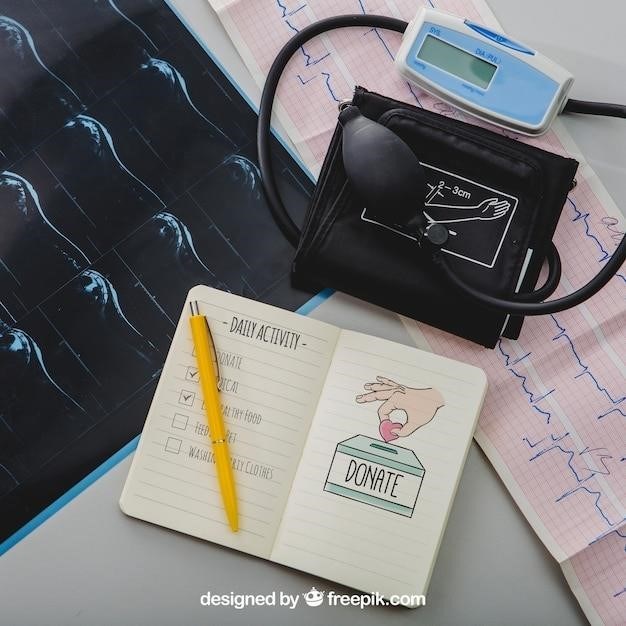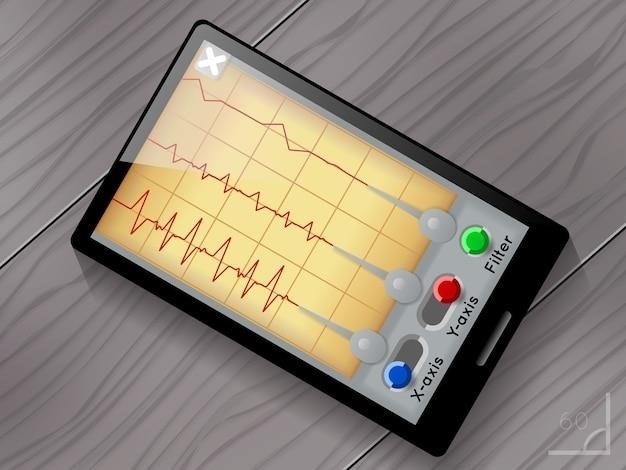Understanding Home Blood Pressure Monitoring
Home blood pressure monitoring empowers individuals to actively manage their cardiovascular health․ Regularly tracking blood pressure readings provides valuable insights into potential hypertension or hypotension․ A printable chart facilitates easy recording and tracking of these vital readings, aiding in effective monitoring and communication with healthcare providers․ This allows for better management of your health․
What is Home Blood Pressure Monitoring?
Home blood pressure monitoring (HBPM) involves regularly measuring your blood pressure at home using a home blood pressure monitor․ This simple yet effective method allows individuals to track their blood pressure readings over time, providing valuable data for managing hypertension or hypotension․ Unlike a single reading at a doctor’s office, HBPM offers a broader picture of your blood pressure patterns throughout the day and over several days․ This consistent monitoring allows for early detection of potential issues and facilitates more informed discussions with your healthcare provider․ The recorded data, often logged on a printable chart like the NHS blood pressure recording chart PDF, forms a crucial part of your overall health management strategy․
Importance of Regular Monitoring
Regular home blood pressure monitoring is crucial for effective hypertension management and cardiovascular health․ Consistent readings reveal trends and patterns often missed by infrequent clinical checks․ Early detection of high or low blood pressure allows for timely intervention, minimizing the risk of serious complications like stroke or heart attack․ Monitoring empowers individuals to actively participate in their healthcare, fostering a sense of responsibility and control․ The data collected, especially when organized using a tool like the printable NHS blood pressure chart, provides a comprehensive overview for doctors, enabling them to make more informed decisions regarding treatment and adjustments․ This proactive approach significantly contributes to better long-term health outcomes․
Benefits of Using a Printable Chart
A printable blood pressure chart offers several key advantages in managing your health․ Firstly, it provides a readily accessible and organized method for recording your daily readings, eliminating the need to search for scattered notes․ This structured approach simplifies the process of tracking your blood pressure over time, making it easier to identify trends and patterns․ Secondly, the chart serves as a valuable communication tool․ When visiting your doctor, a completed chart offers a clear and concise summary of your blood pressure data, streamlining the consultation and aiding in accurate diagnosis and treatment decisions․ Finally, the visual representation of your readings on the chart can enhance your understanding of your blood pressure and its fluctuations, encouraging proactive management of your health․
Using the NHS Blood Pressure Recording Chart
This section guides you on effectively utilizing the NHS blood pressure chart for accurate recording and monitoring of your blood pressure readings at home․ Follow the instructions carefully for optimal results․
Downloading and Printing the Chart
To begin effectively monitoring your blood pressure, you first need to acquire the NHS blood pressure recording chart․ Many NHS websites offer downloadable PDF versions of these charts․ Simply navigate to the relevant page on your local NHS trust’s website or a national NHS health resource site․ Look for a link or button clearly labeled “Blood Pressure Chart,” “Blood Pressure Tracker,” or something similar․ Click on this link to access the PDF file․ Once downloaded, open the PDF using a program like Adobe Acrobat Reader․ From there, you can easily print the chart․ Ensure your printer settings are correct for clear, legible print quality․ This printable chart provides a structured format for recording your daily readings, facilitating organized data collection for your healthcare provider․ Having a physical copy readily available makes the process of regular monitoring more convenient․ Remember to keep the completed chart in a safe place for easy access during your doctor’s appointments․
Recording Blood Pressure Readings Accurately
Accurate recording is crucial for effective blood pressure monitoring․ Before each reading, ensure you are relaxed and have rested for at least five minutes․ Avoid caffeine or exercise immediately beforehand․ Sit comfortably with your back supported and feet flat on the floor․ Position your arm so the cuff is at heart level․ Use an appropriately sized cuff; an incorrectly sized cuff can lead to inaccurate readings․ Take at least two readings, allowing a one-minute interval between each․ Record both systolic (top number) and diastolic (bottom number) readings on your NHS chart, noting the date and time of each measurement․ Include your pulse rate if your monitor provides it․ If readings vary significantly, take additional readings and record them all․ Consistency is key; maintain the same routine and time of day for each measurement․ This consistent approach enhances the accuracy and reliability of your recorded data, providing a clearer picture of your blood pressure trends․ Pay close attention to details during the process for optimal results․
Taking Multiple Readings and Averaging
To obtain a reliable average blood pressure, it’s recommended to take multiple readings․ For each recording session, take at least two readings, separated by a minute of rest․ This helps to minimize the impact of any single, potentially inaccurate reading․ After several days of recording, you can calculate the average․ For example, if you’ve taken readings for a week, add up all your systolic readings and divide by the total number of readings to calculate the average systolic pressure․ Repeat this process for your diastolic readings․ This average provides a more representative picture of your typical blood pressure than a single reading․ The first day’s readings might be disregarded, as you might be adjusting to using the monitor․ This helps to ensure that your average is as accurate as possible and reflects your typical blood pressure levels over time․ Remember to record all individual readings on your NHS chart for a complete picture․

Interpreting Your Blood Pressure Readings
Understanding systolic and diastolic pressure is crucial for interpreting your readings․ Calculating your average blood pressure helps identify trends․ Consult your doctor for personalized advice based on your results and medical history․ This ensures proper management of your health․
Understanding Systolic and Diastolic Pressure
Your blood pressure reading consists of two numbers⁚ systolic and diastolic․ Systolic pressure measures the force of blood against artery walls when your heart beats․ It’s the higher number in your reading․ Diastolic pressure measures the force when your heart rests between beats; it’s the lower number․ Understanding these pressures is key to interpreting your readings․ For example, a reading of 120/80 mmHg indicates a systolic pressure of 120 and a diastolic pressure of 80․ Consistent monitoring of both systolic and diastolic pressures allows for the detection of trends and potential issues․ High blood pressure, or hypertension, is diagnosed when both systolic and diastolic readings are consistently elevated․ Conversely, consistently low readings may indicate hypotension․ Accurate understanding of these values is essential for effective blood pressure management, highlighting the importance of recording both numbers accurately on your printable chart․ Regular monitoring and analysis of these two key values help you and your doctor maintain optimal cardiovascular health․
Calculating Average Blood Pressure
Calculating your average blood pressure provides a more comprehensive picture of your cardiovascular health than individual readings․ To calculate the average, sum all your systolic readings over a specified period (e․g․, a week, excluding the first day as suggested by some resources), then divide by the number of readings․ Repeat this process for your diastolic readings․ This yields separate average systolic and diastolic pressures․ For instance, if your systolic readings sum to 1200 mmHg over 7 days (excluding the first), dividing by 6 results in an average systolic pressure of 200 mmHg․ Similarly calculate the average for diastolic pressure․ This average offers a clearer indication of long-term blood pressure trends, making it easier to identify potential issues and track the effectiveness of any treatment or lifestyle changes․ This calculation is easily done using a calculator or spreadsheet software, making the process straightforward․ Remember to always consult your healthcare provider to interpret the significance of your average blood pressure․
When to Seek Medical Advice
Consistent monitoring using a printable blood pressure chart is crucial, but knowing when to seek professional medical attention is equally important․ If you notice significantly high or low readings consistently, even after excluding the initial readings as suggested in some guidelines, immediate medical advice is necessary․ Similarly, sudden and dramatic changes in your blood pressure, regardless of the average, warrant immediate consultation․ Experiencing symptoms alongside abnormal readings, such as dizziness, headaches, shortness of breath, or chest pain, necessitates prompt medical evaluation․ While average blood pressure calculations provide valuable insights, they shouldn’t replace professional medical interpretation․ Regular check-ups with your physician, coupled with consistent home monitoring using your chart and a discussion of your average readings, are vital for proactive healthcare management․ Don’t hesitate to seek immediate medical attention if you have any concerns about your blood pressure readings or associated symptoms․

Additional Resources and Support
The NHS website offers valuable online blood pressure tools and resources․ The British Heart Foundation provides further support and educational materials to aid in understanding and managing blood pressure effectively․ These resources can complement your home monitoring․
NHS Online Blood Pressure Check Tool
The NHS provides a convenient online blood pressure check tool, readily accessible to the public․ This digital resource allows individuals to input their blood pressure readings, obtaining immediate interpretations and personalized guidance based on their results․ The tool offers a clear understanding of whether the readings fall within healthy ranges or indicate potential concerns․ It provides helpful advice on next steps, recommending consultation with a healthcare professional if necessary․ This user-friendly tool is a valuable supplement to home blood pressure monitoring, offering immediate feedback and support in managing cardiovascular health․ The tool’s simplicity makes it accessible to a wide range of users․ Remember that this tool should not replace regular check-ups with your doctor․
British Heart Foundation Resources
The British Heart Foundation (BHF) offers a wealth of information and support for individuals managing their blood pressure․ Their website provides comprehensive resources, including detailed guides on understanding blood pressure readings, managing hypertension, and maintaining a healthy lifestyle to support cardiovascular health․ The BHF offers educational videos explaining blood pressure in simple terms, making it easier to understand and manage․ They also provide advice on lifestyle changes such as diet and exercise, crucial for blood pressure control․ These resources empower individuals to take control of their heart health, offering practical tips and strategies for long-term well-being․ For more in-depth information, or to find support groups, visit the BHF website․ Remember to consult with your healthcare provider for personalized advice․
